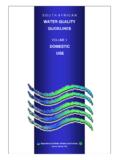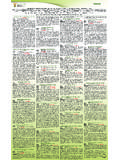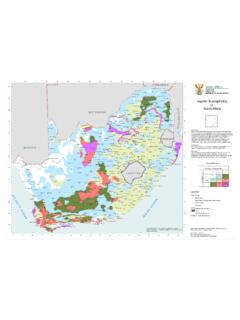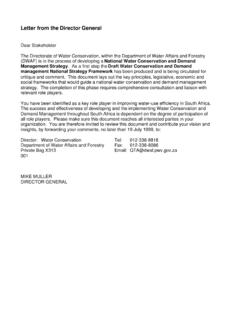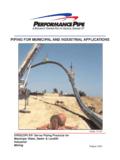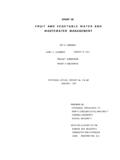Transcription of GUIDELINES - Abattoir Waste Handling and Disposal
1 C:\Leon GUIDELINES Abattoir Page 1 of 4 GUIDELINES FOR THE Handling TREATMENT AND Disposal OF Abattoir Waste DRAFT 1 - 29 AUGUST 2001 1. INTRODUCTION The Abattoir industry processes both red (beef, mutton and pork) and white meat (poultry). The red meat industry comprises in excess of 285 abattoirs. The annual water consumption of the red meat industry, as recorded in 1989, is approximately 5,8 million cubic metres. Approximately 84 % of this water is discharged as wastewater containing high organic loads including suspended matter. The Waste water quality from red meat abattoirs could be broadly summarised as follows: pH 5,7 to 8,4; COD 2380 to 8942 mg / L; suspended solids 189 to 3330 mg / L; TDS 595 to 2805; Total Kjeldahl Nitrogen 0,71 to 24 mg / L.
2 Whereas abattoirs require high quality water due to the processing of a material destined for human consumption (especially abattoirs exporting), discharges from these facilities significantly contributes to the organic load of raw sewage treated at sewage treatment plants. This draft document provides a very brief overview of legal mechanisms and best management practices that could be used to protect the national water resource from unacceptable impacts from the red meat Abattoir Waste . It by no means as is represents a complete draft and only serves as a straw dog for comment and further and appropriate extension.
3 2. SOURCES OF Waste (SOLID Waste AND Waste WATER) IN RED MEAT ABATTOIRS The different sources of Waste in red meat abattoirs could be categorised as: Lairagus / animal pens; Bleeding / stunning; Carcass processing / cleaning; Offal processing; and By-products processing. 3. RELEVANT LEGISLATION Only the two main operative laws, (this discussion could be extended if required) normally used by DWAF, are briefly referred to. Definition of Waste in terms of the National Water Act, 1998 (Act 36 of 1998): C:\Leon GUIDELINES Abattoir Page 2 of 4 Waste includes any solid material or material that is suspended, dissolved or transported in water (including sediment) and which is spilled or deposited on land or into a water resource in such volume, composition or manner as to cause, or to be reasonably likely to cause, the water source to be polluted.
4 Definition of Waste in terms of the Environment Conservation Act, 1989 (Act 73 of 1989): Waste means any matter, whether gaseous, liquid or solid or any combination thereof, which is from time to time designated by the Minister by notice in the Gazette as any undesirable or superfluous by-product, emission, residue or remainder of any process or activity. Technical definition of Abattoir Waste : Abattoir Waste can be defined as Waste or Waste water from an Abattoir which could consist of the pollutants such as animal faeces, blood, fat, animal trimmings, paunch content and urine. Abattoir Waste could therefore be regulated through either the Environment Conservation Act, 1989 (protection of the total environment water, air, soil, humans, flora and fauna), or the National Water Act, 1998 (predominantly protection of the water regime, most possibly excluding seawater quality).
5 Water quality protection in terms of the National Water Act could be achieved via water use licenses (section 21 (f) for discharges excepting into sewage reticulation and 21 (g) for Disposal on land), directives in terms of section 19 for preventing and remedying pollution and section 20 to control emergency incidence involving the spilling of a harmful substance that could detrimentally affect a water resource. Relevant procedural approaches for the preceding exist in documentation cited as Water use authorisation process but needs to be developed for the implementation of sections 19 and 20. The protection of water quality including the environment against the effects of Abattoir Waste disposed of onto land could also be achieved through section 20 (prescribing the need for a Disposal site permit from the Minister of Water Affairs to establish and/or operate a Disposal site) of the Environment Conservation Act.
6 Standards and protocols for the deployment of Section 20 permitting exist in the form of the Minimum Requirement Trilogy (second edition 1998). 4. PROVISIONAL BEST MANAGEMENT PRACTICES DWAF s pollution preventative philosophy based on the sequential approach of Waste prevention, followed by Waste minimisation, re-use and recycling and only then Waste discharge or land Disposal at prescribed water quality or Disposal standards (providing for exemption in well motivated cases) applies. However, based on current knowledge no South African Abattoir operates on a closed water circuit. The reason for this is that wastewater streams generated by abattoirs contain high levels of pollutants.
7 It is generally prohibitively costly to treat to a water quality standard, which is fit for recycle or re-use (especially in view of the high intake water quality required). Most abattoirs discharge (after appropriate pre-treatment) to municipal sewer. These effluents have to comply to municipal by-laws which could be typically described as: C:\Leon GUIDELINES Abattoir Page 3 of 4 COD 3000 to 5000 mg / L; TSS 500 mg / L; NH3-N 200 to 300 mg / L; pH 6 to 10. Waste discharges into watercourses must comply with the general standard or receiving water quality objectives based on an appropriate level of Reserve determination.
8 The most widely used route for Disposal of Abattoir Waste is municipal sewers. Discharge costs due to the high organic strength of untreated Abattoir Waste is relatively high. Abattoirs normally also have difficulty in meeting municipal by-laws for fats, oils, greases and suspended solids. A degree of on-site pre-treatment is therefore preferable, however, to minimise Waste volumes, water conservation and optimum water housekeeping are essential. In addition to good Abattoir housekeeping, Abattoir Waste management should be progressively implemented commencing with low cost, low technology practices and thereafter progressing to more sophisticated technologies.
9 Best management practices which broadly applies in terms of pre-treatment include: Solids separation by screening; Fat / oil removal by flotation / skimming; Primary settling; Blood separation (protein recovery); Waste effluent balancing; pH correction (chemical correction); Protein recovery Ultra filtration; Reverse osmosis. If required further explanatory text (with possible inclusion of design examples) could be provided in the next draft for each of the above unit processes. Abattoirs aim at optimising the recovery of edible portions from the meat processing cycle for human consumption. Significant quantities of secondary Waste materials not suitable for further consumption are however generated.
10 Since water is often used to wash excessive Waste solids to drain, Waste solids should be carefully managed to promote water conservation. Types of solid Waste resulting from pre-treatment could be summarised as: Dewatered solids mainly hair, stomach fibres / residues; Disposal routes could include removal by farmers for pig feed, compost supplementation or Disposal to landfill (permitted) with chlorine lime pre-treatment, trenching and covering; Fat / oil skimmings could be landfilled (permitted) with chlorine lime pre-treatment, trenching and covering; Blood solids, normally converted into blood meal, however at small abattoirs blood represents a severe problem; Hides could be sent to tanneries for processing leather.


